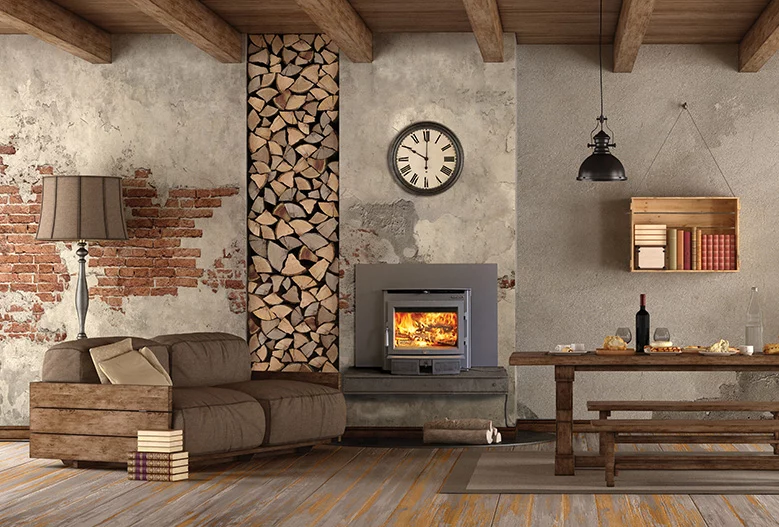Wondering how to prepare your wood-burning fireplace for chilly fall nights?
As summer fades away and temperatures drop, it’s time to think about preparing the fireplace for those chilly fall days ahead. Before your fireplace goes back into full swing, it needs an inspection and cleaning, to ensure its longevity, aesthetic, and–most especially–safety. Fall is the best time to complete your yearly fireplace maintenance and cleaning. In fact, the week of October 2 is National Chimney Safety Week.
In this article, you’ll learn how to prepare your wood-burning fireplace for the fall, with a step-by-step guide for inspecting it from the top of the chimney to the hearth. You’ll also learn how to clean it for maximum burning efficiency and safety on those cold nights.
Protective gear for you and your room
Inspecting and cleaning a fireplace requires a bit of preparation before you even begin, because soot, which is very lightweight, will escape as it’s loosened. It’s not safe to breathe and will get all over your clothes and could also reach the carpet and furniture, potentially leaving nasty stains as it goes.
Before you begin, don your painting clothes, tarp up the floor and nearby furniture, and put on a dust mask, gloves, and safety glasses.
Check for damage
Over time, as with anything else, wear and tear can become troubling damage. With chimneys, that trouble could mean a house fire. Most chimney fires go undetected. If you notice cracks in your chimney, a discolored chimney cap, creosote flakes, or warped metal on your damper, these can be indications that your chimney has had fires, and will again, unless the creosote is addressed.
As you clean, you’ll want to check each area for cracks or other damage. You’ll definitely need a flashlight or shop light.
1. Firebox
The firebox will need close inspection, made easier once it’s cleaned of soot and debris. The integrity of your firebox can be compromised by cracks, and shifting or loose bricks from your house settling, earthquakes, and age.
2. Damper
With a flashlight, and face and eye protection firmly in place, check your damper to make sure it moves freely and you can see daylight, confirming that it’s open.
3. Chimney
If you didn’t see daylight when you checked the damper, but it seemed to move, you may need to check that no critters have taken residence in your chimney, by doing an inspection on the roof. A grate over the top of the chimney will prevent future intrusions. Check your chimney for debris, cracks, and extensive creosote buildup.
Chimney Cleaning
Like cleaning walls, or dusting before you vacuum, it’s best to clean your fireplace from the top, down. When it comes to the chimney, you can clean the portion that you can reach with a wire brush. If you’re finding a lot of creosote buildup, it can indicate that the buildup extends far beyond your reach.
The highly corrosive and flammable creosote can cause chimney-damaging fires. We recommend hiring a professional chimney sweep at least every few years, or more often, depending on how much you use your fireplace. They have special equipment to clean your entire flue and can expertly check for damage.
Firebox Cleaning
Cleaning the firebox also requires a wire brush. Again, start from the top and work your way down, checking for damage as you go. Once you have the walls and floor of the wire box scrubbed, you can follow up with a vacuum cleaner with a hose.
Exterior Cleaning
With the messier part of the job out of the way, it’s time to clean the exterior. In addition to cleaning, you’ll want to make sure that the hearth remains clear of anything but the screens, fireplace tools and logs. During warmer months, the space may have accumulated items that can be fire hazards when the fireplace is in use.
Hearth and Face
Cleaning the exterior brickwork or stone, can be done using a nylon or wire brush, and non-chemical–and therefore non-flammable cleaner.
There’s no need to scramble for a fireplace cleaner. Everything you need is likely in your kitchen: vinegar or baking soda, and cream of tartar.
Follow these easy steps to clean the brick or stone on the exterior of your fireplace:
- Soak the brick with diluted white vinegar OR Apply a paste of baking soda and water
- Leave it for 15 minutes
- Scrub with a wire brush
- Scrub stubborn stains with a paste of cream of tartar and water
- Wipe and rinse off cleaning products
- Let air dry
Doors or screens
It’s important to keep the flammable and unsightly residue cleaned from your glass doors with glass cleaner and keep the screens dusted and wiped down. Also, check the glass for fractures and the mesh of your screens for cracks, breaks or weak spots.
Hiring a professional
Cleaning your fireplace annually is an essential part of prolonging the beauty of your fireplace and ensuring your safety while enjoying it. If you have any questions about how to keep your fireplace clean and in good condition, the experts at Creative Energy can help.
Or, for greater peace of mind, reach out to Creative Energy and let one of our fireplace technicians conduct the inspection for you. We also invite you to visit one of our Bay Area showrooms in San Rafael, San Mateo, or Concord to meet with a specialist in person and perhaps discuss upgrading your woodburner with a new insert.

